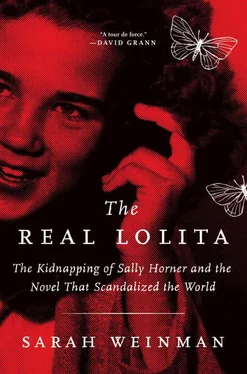Staring at the scrapbook, Rachel knew she had to speak up now or she would never be able to say the words again.
“Mom, there’s something I need to tell you. Something I never told you. Frank La Salle didn’t only molest Sally. He also molested me.”
ONE AFTERNOON while Sally Horner was at school, Frank La Salle invited Rachel over to his trailer. At age five, Rachel wore her white-blond hair in pigtails, a ribbon adorning the left plait. She put on her favorite striped black-and-white dress every chance she got. One portrait of Rachel from that time depicts her as the ideal of innocence. Her smile is trusting, guileless. Her expression is pliant, hinting at a gullible streak that would plague her repeatedly in adulthood.
She might have been by herself, or with one of her sisters. What she most recalled was that Frank was nice to her. He seemed to understand what Rachel wanted. That she saw what Sally had—toys, games, a father’s love—and didn’t have them. Not the toys. Not the games. And her father, George, was a remote presence, more comfortable with adults than with his children.
Of all the things Sally possessed, what interested Rachel most were her crayons and coloring books. They reminded Rachel of an earlier stay at a Minnesota hospital when she was three, quarantined for months with rheumatic fever. She went to school at the hospital because she wasn’t allowed to go home. There were troubles, both at home and in the hospital, the kind so traumatizing Rachel would not remember them for decades without the trigger of unexpected smells and brief image flashes. But what came back to her now was the memory of her parents visiting with big smiles and good cheer, and of learning how to draw with crayons.
Frank made Rachel a deal: She could play with anything of Sally’s. Anything at all. But she had to do favors for him first.
“Essentially, what he wanted from me was to give him a blow job,” Rachel said. “So I did.”
Rachel remembered a single incident. There may have been others that she blocked out. She didn’t remember it until after she was married, and her husband wanted the same thing. The sexual act seemed disgusting to the newly married Rachel, and it would take her years to learn it flowed from normal, healthy desire.
She only realized the enormity of what Frank had done to her when she stumbled across a pamphlet at the local library, long after the end of her marriage. The pamphlet was about child molestation. Its title: “He Told Me Not to Tell.”
Frank La Salle had told Rachel not to tell. But Rachel would have stayed silent regardless. The girl’s earlier hospital experience taught her not to trust adults. They could abandon you for months. They could leave you alone and never tell you when you might come home. And when you did come home, you didn’t know what awaited. Whether it was a safe haven or a recurring nightmare.
While telling the story to me nearly forty years after the fact, Rachel would recall that when she told her mother what La Salle had done, a barrier went up right away between herself and Ruth. Like an electrified fence where venturing too close might lead to a surprise shock. She felt her mother shut down. Rachel decided to change the subject to safer territory. She had taken a risk and it did not work. When that happened, as it had so many times in her past, the best thing to do was to be like a turtle. Retreat within the shell and never reveal your vulnerable self again.
Afterwards, she and Ruth would never be as close. (There would be other visits, including a reunion of all but one of Ruth’s children in 1998, six years before Ruth died.) Rachel sensed her mother must have known, on some level, why there was a new breach between them. Perhaps, Rachel theorized, her mother had helped Sally Horner because she knew she could not save her own children from nearby monsters. But letting her thoughts run in this direction was too much for Rachel. She suspected Ruth never allowed herself to contemplate her complicity in the damage done to her own children.
No wonder Ruth acted as if the conversation never happened. The subject never came up between them again. Neither did Lolita .
Sally Horner’s premature death cast a pall on the lives of those who knew her best and loved her most. Ella, who did not display much of her inner turmoil while Sally lived, buried it completely after her daughter’s death. She could not think of another way to handle it besides burying her emotions, but at least she did not have to bear her grief alone. The Panaros remained nearby. Ella could watch her granddaughter, Diana, grow up.
A year before Sally died, Ella had connected with a new partner: Arthur Burkett, a Camden native five years her junior, who moved into 944 Linden Street. They decamped for Pennsauken, five miles away, within a year of the car accident that killed Sally, and in the early 1960s migrated west to Palo Alto, California—less than an hour’s drive away from the San Jose trailer park where Sally had been rescued. Burkett found work as a groundsman for a local college, and Ella and Ott, as he was called, made their union legal in January 1965.
Five years later, Burkett was dead. His tractor had overturned on him as he cut grass on a steep hill on the college grounds. While he was recuperating from the accident, doctors discovered he had gastric cancer, which had already spread to his liver. Without any other ties to Palo Alto, after he died Ella returned to New Jersey to be closer to her family.
When she visited her family, she never spoke of what happened to Sally. She didn’t speak much of the past at all. There didn’t seem to be much purpose in revisiting painful memories with a generation that hadn’t been born when the worst had happened. Ella preferred to play cards—gin rummy was a favorite—or talk about what books she liked to read. Mystery novels, in particular.
Ella’s silence about what happened to her younger daughter carried over to the next generation. Diana didn’t learn the truth that her dead aunt Sally had been kidnapped until she was in her teens. She didn’t remember the exact details of the conversation she had with her father about Sally, but she recalled it didn’t last long. A mere recounting of the basic facts: that before her aunt died, she had been taken by a stranger posing as her father. The rest was left up to Diana’s imagination.
Diana was only four years old when Sally died. Her parents were chiefly concerned with making sure their daughter had a happy childhood, and hiding their hurt, however deep the wounds ran. Just as Susan didn’t speak much about her younger sister, neither did Al speak of his experiences in World War II. It seemed easier to keep the past behind a locked door and to keep silent on family tragedy.
“I still can’t believe something like this happened in my family,” Diana told me. “I never got to know my aunt Sally. I also wish I could have been able to support my mom during that awful period.”
By this point, the Panaros had had a son, Brian, born in 1968, twenty years after Diana. Susan and Al had given up on the greenhouse well before Brian’s birth (a surprise pregnancy after several additional miscarriages made the likelihood of another child seem all the more remote). They had also left New Jersey for South Carolina, with Ella joining them for a time, though they would return to their home state in the mid-1970s. Susan became a full-time homemaker. She spent ample time gardening—for pleasure, not for income—volunteering with her church, and with her family.
When the Panaros returned to New Jersey, Ella settled back in New Egypt, where she had spent much of her childhood and early motherhood. She then moved to a nursing home in Pemberton, where she died in 1998 at the age of ninety-one. Susan died in 2012, and Al passed away in February 2016.
Читать дальше












